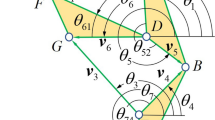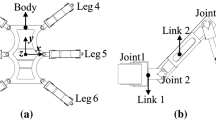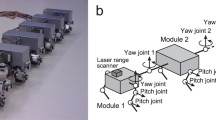Abstract
Multi-legged animals such as myriapods exhibit highly adaptive and effective locomotion on rough terrain. They achieve this locomotor performance by coordinating their flexible bodies and legs in response to the environmental situation. To capture the essential motor control mechanisms in centipedes, we have constructed mathematical models based on behavioral findings. Although our latest model succeeded in producing adaptive centipede walking on irregular terrain, the simulated centipede sometimes became stuck because of head collision with an obstacle in front. To overcome this limitation, in this paper, we added a simple reactive head motion control in which a few anterior body segments actively bend to keep the head section from becoming stuck. Through simulation experiment, we verified that the proposed head motion control improves the centipede-like robot’s ability to traverse rough terrain with many gaps.
Access this chapter
Tax calculation will be finalised at checkout
Purchases are for personal use only
Similar content being viewed by others
References
Manton, S. M.: The evolution of arthropodan locomotory mechanisms. Part 3. The locomotion of Chilopoda and Pauropoda. J. Linn. Soc. (Zool.) 42, 118–166 (1952)
Ozkan-Aydin, Y., Chong, B., Aydin, E., Goldman, D.I.: A systematic approach to creating terrain-capable hybrid soft/hard myriapod robots. In: 2020 3rd IEEE International Conference on Soft Robotics (RoboSoft), pp. 156–163 (2020)
Ambe, Y., Aoi, S., Tsuchiya, K., Matsuno, F.: Generation of direct-, retrograde-, and source-wave gaits in multi-legged locomotion in a decentralized manner via embodied sensorimotor interaction. Front. Neural Circuits 15, 706064 (2021)
Yasui, K., Sakai, K., Kano, T., Owaki, D., Ishiguro, A.: Decentralized control scheme for myriapod robot inspired by adaptive and resilient centipede locomotion. PLoS ONE 12, e0171421 (2017)
Kano, T., Sakai, K., Yasui, K., Owaki, D., Ishiguro, A.: Decentralized control mechanism underlying interlimb coordination of millipedes. Bioinspir. Biomim. 12, 036007 (2017)
Yasui, K., Takano, S., Kano, T., Ishiguro, A.: Adaptive centipede walking via synergetic coupling between decentralized control and flexible body dynamics. Front. Robot. AI 9, 797566 (2022)
Acknowledgements
This work was supported by the JSPS KAKENHI (Grant Number JP21K14177) and the research fund from the Frontier Research Institute for Interdisciplinary Sciences, Tohoku University.
Author information
Authors and Affiliations
Corresponding author
Editor information
Editors and Affiliations
Rights and permissions
Copyright information
© 2022 The Author(s), under exclusive license to Springer Nature Switzerland AG
About this paper
Cite this paper
Yasui, K., Takano, S., Kano, T., Ishiguro, A. (2022). Simple Reactive Head Motion Control Enhances Adaptability to Rough Terrain in Centipede Walking. In: Hunt, A., et al. Biomimetic and Biohybrid Systems. Living Machines 2022. Lecture Notes in Computer Science(), vol 13548. Springer, Cham. https://doi.org/10.1007/978-3-031-20470-8_26
Download citation
DOI: https://doi.org/10.1007/978-3-031-20470-8_26
Published:
Publisher Name: Springer, Cham
Print ISBN: 978-3-031-20469-2
Online ISBN: 978-3-031-20470-8
eBook Packages: Computer ScienceComputer Science (R0)




